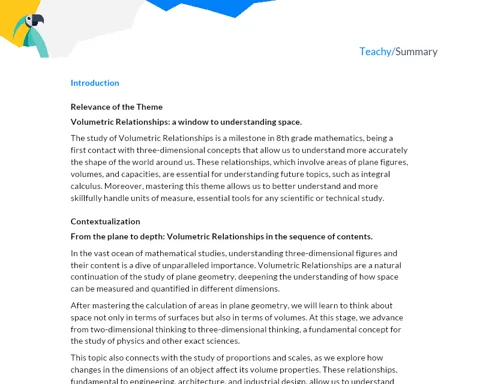Spatial Geometry: Volume of Cones | Active Summary
Objectives
1. 🎯 Understand and calculate the lateral surface area and total area of a cone.
2. 🎯 Apply mathematical formulas for area calculations in practical and real-life situations.
3. 🎯 Develop estimation and precision skills in measurements for application in design and engineering projects.
Contextualization
Did you know that the formula for calculating the area of a cone was discovered by the famous Greek mathematician Archimedes? He not only unveiled this formula but also applied it to solve practical problems in his time, such as calculating the volume of grains in a conical-shaped silo. This shows that spatial geometry is not just an academic tool but a key to solving real challenges in various fields, from architecture to engineering. Let's explore how these concepts can be applied in practical and innovative situations!
Important Topics
Lateral Surface Area of a Cone
The lateral surface area of a cone is given by the formula A = π * r * l, where 'r' is the radius of the cone's base and 'l' is the slant height, the distance between the cone's vertex and any point on the circumference of the base. This formula is fundamental for calculating the amount of material needed to cover or coat the surface of a cone, being crucial in practical applications such as the construction of traffic cones and architectural structures.
-
The lateral surface area of a cone is proportional to its radius and slant height, meaning that changes in these measurements directly affect the amount of material needed.
-
The concept of slant height is essential for understanding the incline and height of the cone, directly impacting its total surface area.
-
The application of this formula in real-life projects, such as making paper cones for ice cream, highlights the importance of spatial geometry in everyday life.
Total Area of a Cone
The total area of a cone includes the lateral surface area and the base. The complete formula is A = π * r * l + π * r², where the addition of the term π * r² represents the area of the cone's base. This concept is vital for calculations involving the volume of materials in conical objects, such as storage tanks and chimneys.
-
The total area of a cone is the sum of the lateral surface area and the base area, which broadens the understanding of the cone's geometry and its interaction with space.
-
The base of a cone, often a circle, adds an extra dimension to the total area calculation, which can be a conceptual challenge for some students.
-
Understanding this formula is essential for applications ranging from packaging design to architecture, where conical surfaces are common.
Practical Applications of Cone Area Calculations
The calculations of cone areas have a wide range of practical applications, including the design of everyday objects such as traffic cones and packaging. Moreover, they are fundamental in more complex engineering and architecture projects, where precision is crucial for project success.
-
In civil engineering, the calculation of cone areas is used to design efficient structures, such as overpasses and tunnels with conical cross-sections.
-
In interior design, knowledge of these formulas helps optimize space usage, especially in environments with unconventional shapes.
-
The ability to apply mathematics in real contexts, such as calculating materials for construction or decoration, highlights the importance of mathematics in solving everyday problems.
Key Terms
-
Cone: A three-dimensional geometric figure with a circular base and a single vertex (or apex).
-
Lateral Surface: The curved face of a cone that connects the base to the apex.
-
Slant Height: The straight line that connects the vertex of a cone with any point on the circumference of the base.
To Reflect
-
How do changes in the radius and height of a cone affect its total area and the amount of material needed to cover it?
-
Why is it important to consider precision in measurements when calculating areas of geometric figures for practical applications?
-
In what ways is the study of spatial geometry and the calculation of areas of conical surfaces relevant to your future career or professional interests?
Important Conclusions
-
We reviewed the calculation of the lateral surface area and the total area of a cone, essential for applications in engineering, design, and many other fields.
-
We understood how small variations in the radius and height of a cone can mean large differences in the amount of material needed to cover it.
-
We discussed the importance of precision in measurements and how it directly affects the efficiency and success of practical projects involving conical figures.
To Exercise Knowledge
- Create a cone model using recyclable materials and calculate its areas. 2. Use 3D modeling software to visualize different cones and calculate their areas. 3. Draw up a plan for decorating a party, including cones, and calculate the amount of fabric needed.
Challenge
Propose a design challenge: create an innovative object that creatively utilizes the shape of a cone, such as a new kitchen utensil, and present a report on how area calculations influenced the design.
Study Tips
-
Practice drawing cones and calculating their areas in different situations, such as varying slopes and different base sizes.
-
Use math applications and online simulations to explore concepts of spatial geometry and see their practical applications in real time.
-
Discuss with your friends or family how the concepts of cone areas can be applied in your professions or hobbies to see mathematics in action in everyday life.



